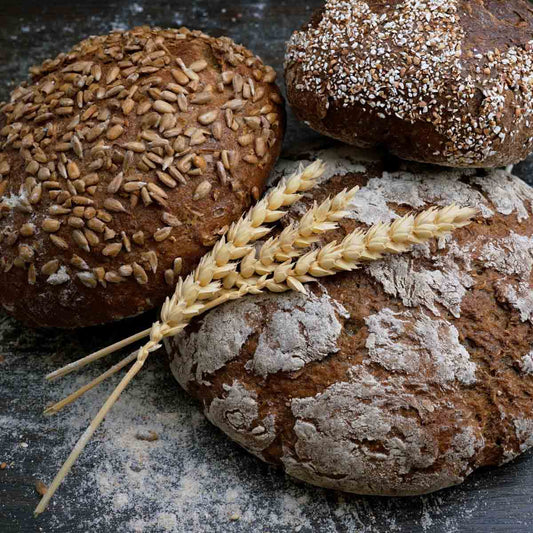What are the Health Benefits of Whole Grains?
First, What Are Whole Grains?
Grains are the seeds of grass-like plants called cereal crops. These include wheat, oats, barley, rice, spelt, rye, corn, teff, and many others. Regardless of the species, these nutritious seeds are composed of three edible parts: the bran, the endosperm, and the germ. A whole grain is simply a seed that contains all three elements. It doesn't matter if it's milled into flour, rolled (as in rolled oats), sprouted, or served whole. It counts as whole grain as long as it has 100% of the bran, germ, and endosperm in place.
The Bran
This is the outer skin of the grain, and it contains valuable nutrients like protein, fiber, B-vitamins, iron, zinc, copper, magnesium, and phytochemicals.
The Germ
The germ is the embryo of the grain, the part that can sprout into a new plant. It's a tiny nutritional powerhouse within the seed that contains B-vitamins, protein, minerals, and healthy fats.
The Endosperm
The endosperm makes up the majority of the caloric value that grains offer. It's composed of starchy carbohydrates and protein, and to a lesser extent, some vitamins and minerals. In nature, when a seed decides to germinate, it uses the stored energy in the endosperm as its primary food source to fuel its growth.
What are Refined Grains?
Refined grains, like white flour, have been sifted so that the germ and bran are entirely removed. All that's left is the starchy endosperm. This means it's lacking all of the great dietary fiber, b-vitamins, minerals, antioxidants, and delicious flavor of whole grains.
The Health Benefits of Whole Grains
1) Excellent Source of Vitamins
Whole grains are an excellent source of B-vitamins. They're exceptionally high in niacin, thiamin, and folate, and they also contain vitamins B6, B5, B2, and vitamin E
2) High in Minerals
Grains are high in various minerals, including iron, magnesium, phosphorus, potassium, zinc, copper, manganese, and selenium.
3) Loaded with Dietary Fiber
Thanks to their outer bran, whole grains are high in dietary fiber. Fiber is the structural part of plant material that your body can't digest. It doesn't provide any nutrients or calories. Instead, it passes through your digestive system intact. The two main fiber types are soluble fiber and insoluble fiber, both of which are found in whole grains.
3) Rich in Prebiotic Fiber
But wait, there's a whole other type of fiber too! Whole grains contain prebiotic fibers, including beta-glucans and arabinoxylan-oligosaccharides (AXOS). Prebiotics are indigestible fibers composed of oligosaccharides that feed beneficial gut bacteria and promote a healthy and diverse gut microbiome.
4) Powerful Antioxidants
Whole grains are also rich in polyphenols, which act as powerful antioxidants. These include phenolic acids, flavonoids, tannins, plant-sterols, and others. Antioxidants prevent or reverse the damage done to your cells caused by environmental factors or aging by scavenging free radicals.
5) Gut Friendly Resistant Starch
Resistant starch is a type of starch that resists being digested, as the name suggests. Instead of being broken down into glucose, it passes through your digestive system unchanged until it reaches the colon, where it is fermented by beneficial gut bacteria. So it actually acts like a prebiotic.
Resistant starch has a whole bunch of benefits. It slows down the release of glucose during digestion, which lowers the glycemic index of the foods they're a part of and helps reduce insulin resistance. It supports gut health by stimulating healthy flora in your microbiome. Resistant starch can also improve digestion and make you feel more satiated from a meal.
6) Delicious Flavor
Yeah, not really a health benefit, I know. But high-quality whole grains, like spelt and heritage wheat varieties, contribute far more flavor and depth to foods than refined grains. Many of the delicious, rich, nutty flavors in whole grains come from the very properties that make these foods nutritious; the oils in the endosperm, the earthy bran, the tannins, and other polyphenols.
The Catch
There's one significant catch here. The human body, on its own, can't properly digest grains and realize their total nutritional value. For grains to nourish us best, they need the pre-digestive powers of fermentation.
A primary reason is that grains contain antinutrients, like phytic acid, which binds to vitamins and minerals and prevents nutrient absorption. They also have trypsin inhibitors and amylase inhibitors, which hinder starch digestion and can contribute to adverse reactions to whole grains, including digestive distress, IBS, and more.
Does this mean we shouldn't eat grains?
No, of course not. The nutrients stored in grains can be unlocked using traditional preparation methods. This is why human cultures worldwide have developed so many different techniques to activate grains. If you're a frequent reader of this blog, then you'll know we're passionate about one approach in particular: sourdough fermentation. Fermentation activates grains by neutralizing antinutrients, breaking down complex starches into more digestible short-chain starches, and degrading protein structures (like gluten). It also synthesizes beneficial nutrients and compounds like B-vitamins, amino acids, and lactic acid. This ancient practice pre-digests grains and transforms them into a highly digestible, nutrient-rich, and delicious staple food.




